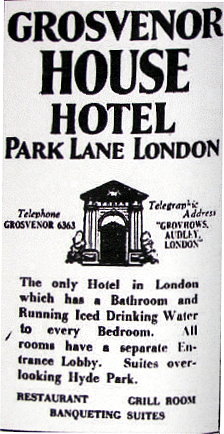Until the 1730s, the site on which the hotel now stands was
described as meadows and ‘swampy meads’. The first building on the site was a
large detached house located on the south side of Upper Grosvenor Street. The
house passed through several owners, including the Duke of Cumberland and The
Duke of Gloucester. The property changed hands again in 1806 when Lord
Grosvenor purchased Gloucester House (as it was then known) and in 1808, he
re-named it Grosvenor House. It remained the Grosvenor family’s London home for
over 100 years.
Grosvenor House facade c1800 (via)
At the outbreak of the First World War the house was put at
the disposal of the Government, and occupied by the Food Controller’s
Department until 1920. It was then put up for sale and purchased by a
commercial speculator by the name of Mr. A. O. Edwards. It was Edwards who
built what is now the Grosvenor House Hotel. The architect was L. Rome Guthrie,
with external elevations by Sir Edwin Lutyens.
Work began in April 1927 and was completed in
the spring of 1929. Not everyone approved of Mayfair’s new landmark. In a
letter to The Times, it was described as an insult to the good taste and
aesthetic judgement of the citizens of the metropolis.
The Grosvenor House Hotel (via)
The hotel opened its doors to the public on the 14th May,
1929. A press release announced the standard set by Grosvenor House begins with
better food, wines, services and private accommodation than has so far been
achieved, and it ends with a diversity of social and recreational amenities. In addition, the hotel was the first in
London to have a bathroom and running iced water to every bedroom.
26 September 1929 - Yorkshire Post and Leeds
Intelligencer
I’ve read that Queen Elizabeth II learnt to skate on the
Grosvenor House Hotel ice rink. I have no way of knowing if that little piece
of information is correct. The hotel certainly housed an ice rink until 1934
when it was converted into a banqueting space.
World War II brought dramatic changes to the hotel. The Great Room became home to the Officers’ Sunday Club. The hotel was also used briefly used as an annexe to the Immigration Section of the US Embassy; and in 1943, the hotel became the largest US Officers’ mess, serving 5.5 million meals in two years.
A 92 bedroom extension was added to the hotel in 1956. This
was only made possible after the death of Baron Bruno Schröder, who had
acquired the lease of 35 Park Street in about 1910, and refused to give it up.
He remained in his house until his death in 1943, when permission to demolish
the building was finally given.
While considering what to contribute to this week's Sepia Saturday, I
remembered this photograph taken at the Grosvenor sometime in the 1980s.
I'm at the front on the right as you look at the picture
sitting next to my husband (he with the snazzy red bow tie). We have absolutely
no recollection of the names of the people sitting with us. We were introduced on the night but didn't meet them again, which was often the
way with these events. The only reason we can safely say the photograph was
taken at The Grosvenor is because it is in one of their photo sleeves. We can't
even remember what the occasion was other than to say it was probably a Ford
Motor Company dinner. My only abiding
memory from the night is of being mightily impressed by the exterior of the
building.
More recent years have seen a great many changes at The Grosvenor. It was purchased by The Royal Bank of Scotland in 2001 to be managed by Marriott International and rebranded the Grosvenor House a JW Marriott Hotel. It underwent a four-year renovation and restoration costing £142 million, reopening in 2008. In 2010, the Indian financial services group Sahara India Pariwar purchased the hotel from Royal Bank of Scotland for £470 million.
An announcement in the press on March 2nd, 2015 brings the story more or less up to date; Deloitte was today appointed to handle the administration of Sahara Grosvenor House Hospitality Limited, which owns the long leasehold, on behalf of Bank of China. The underlying operating lease with Marriott, which operates the hotel, is unaffected by the appointment and the hotel continues to trade as normal. The rest of the newspaper article is available here
This is my contribution to Sepia Saturday 290; Hotels - Illustrations - Design
That concludes our tour of the 'Grand Dame of Park Lane'. It’s now time to pack your overnight bag for a visit to Sepia Saturday.
That concludes our tour of the 'Grand Dame of Park Lane'. It’s now time to pack your overnight bag for a visit to Sepia Saturday.
















